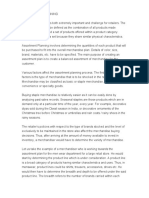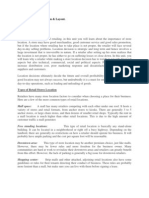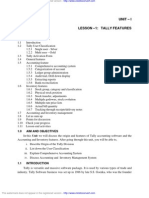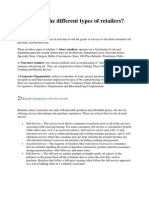Merchandise Budgets
Merchandise Budgets
Uploaded by
Arnun Kumar SahuCopyright:
Available Formats
Merchandise Budgets
Merchandise Budgets
Uploaded by
Arnun Kumar SahuCopyright
Available Formats
Share this document
Did you find this document useful?
Is this content inappropriate?
Copyright:
Available Formats
Merchandise Budgets
Merchandise Budgets
Uploaded by
Arnun Kumar SahuCopyright:
Available Formats
Q.
Planning merchandise Needs & Merchandise Budgets
Merchandise Planning is "A systematic approach. It is aimed at maximising return on investment, through planning sales and inventory in order to increase profitability. It does this by maximising sales potential and minimising losses from mark - downs and stock - outs." Merchandise Management
The planning and control of merchandise inventories to meet desired sales and product-related objectives.Also includes the planning of the size and composition of the merchandise inventories, as well as a variety of functions dealing with the purchase, display, pricing, promotion, and sale of merchandise. Merchandise Planning Marketing the right merchandise at the right place at the right time in the right quantities at the right price.Involves those activities which are needed to ensure a balance between inventories and sales.Management of the product component of the marketing mix. Essential Terms Product: what retailer is selling (or service). Product line: all products/services offered by retail firm. Category: assortment of items that the customer sees as reasonable substitutes for each other. Assortment: range of choices/selection in a given product line (# of SKUs in a category) Inventory turnover: # of times the avg. inventory of an item or SKU is sold, usually in annual terms
Merchandise Assortment Width (Breadth): refers to assortment factors necessary to meet needs of target market and competition Brand of Beer Types Sizes o Coors reg., light 6-pk, 12-pk o Miller o Budweiser o Michelob SKUs = 16 Support (Depth): Determination of how many units of merchandise are needed to support expected sales of each assortment factor (e.g. brand, type, size, color, etc.) Rely on customer needs, past sales trends, image of department and store, etc.
Merchandise Planning Objective Ensure that both the customers merchandise needs and the retailers financial requirements are satisfied by creating an acceptable balance between merchandise inventories and sales. Merchandise Budgeting A merchandise budget may be defined as a plan that forecasts specific merchandising activities for a department or store for a specific period of timeThe buyer will work with numerous store executives in developing a plan to guide him or her in the various phases of the merchandising activity. For example, the finance manager will provide information regarding the availability of funds, future cash needs etc. The merchandise manager will provide valuable guidance based on company objectives and procedures and will maintain a proper balance among the departments under his jurisdiction with regard to departmental opportunities and needs. A buyer will rely on past experience, on his or her ability as a manager and merchandising objectives when planning a workable merchandise budget.
Once all available information regarding business conditions, consumer trends, market and supply conditions, competition, business philosophies and future forecasts are gathered, actual planning for the year ahead may begin.A small store will usually adopt a six month plan that is very simple. For example, the desired results of the various merchandising activities for a specific period are put down on paper in the form of financial figures. Comparisons and adjustments are made at frequent intervals in relation to the actual performance. Planning Annual Sales Annual sales estimates o time series o judgmental forecasting Make monthly sales estimates
Forecasting Sales Staples: demand year-round (appliances, hardware, etc.). Consider sales trends, profitability, quantity discounts Seasonal Merchandise: use past knowledge, info. from vendors, length of season, planned sales, selling price Style and perishable items.
Example : Als Party Shop wants to maintain a 3-week supply of domestic beer in inventory and average sales of Miller Lite beer are 500 6-packs per week. The order point is 1500 (500 X 3 weeks). When inventory drops below 1500, more beer should be ordered. Suppose the order interval is 2 weeks. We must consider to include stock to maintain during the order interval and add to our order point -- in order to determine our order ceiling. Order ceiling=Order point+Order interval sales. o 1500 + (500 X 2) = 2500 We can then determine our order quantity by subtracting stock on hand from order ceiling. o Order Quantity = Order ceiling - stock on hand
Inventory Turnover Turnover @ retail Retail sales/Avg. inv. in retail $ Turnover @ cost Cost of goods sold/avg. inv. at cost Total $ Available for Sale= BI + Purchases COGS=Total $ available for sale - Ending inventory Turnover based in units of units sold/Avg. inv. in units
Determining Stock-to-Sales Ratio Divide the turnover figure into 12 (months in year) to determine the number of times of merchandise needed to support the desired sales based on turnover
Examples: Turnover = 4; Stock-to-sales = 3.0 Turnover = 2.8; Stock-to-sales = 4.28 Turnover = 10; Stock-to-sales = 1.2 Lower the turnover, the higher the stock-to-sales ratio
Calculating BOM Stock-to-Sales Ratios Step 1: Calculate sales-to-stock ratio o GMROI=gross margin% * sales-to-stock ratio Step 2: Convert sales-to-stock ratio to inventory turnover
o Inventory turnover = sales-to-stock ratio * (100% - Gross margin %, expressed as decimal) Calculate average stock-to-sales ratio Average stock-to-sales ratio = # months/inventory turnover Calculate monthly stock-to-sales ratios
Stock ratios considerations Dont confuse stock-to-sales ratio with the sales-to-stock ratio Sales are the same in both ratios Stock in the sales-to-stock ratio is the average inventory at cost over all days in the period Stock in the average stock-to-sales ratio is the average BOM inventory at retail BOM stock-to-sales ratio is an average for all months
GMROI & Sales-to-Stock GMROI = gross margin return on inventory investment measures how many gross margin dollars are earned on every dollar of inventory investment Sales-to-stock ratio = net sales/avg. inv. GMROI = gross margin/avg. inv. GMROI combines the effects of profits and turnover.
Calculating Open-to-Buy for Current Period Calculate Projected EOM stock Actual BOM stock + monthly additions + order amount - Planned monthly sales planned monthly reductions
Open-to-buy = Planned EOM stock - Projected EOM stock
Calculating Open-to-Buy for Future Periods Calculate projected EOM stock Projected BOM stock + actual order - monthly sales - planned reductions
Open-to-buy = Planned EOM stock - Projected EOM stock.
Analyzing Merchandise Performance ABC Analysis o Rank order merchandise categories (SKUs) by some performance measure Contribution margin Sales Dollars/Units Gross margin Gross margin return on investment Sales or gross margin per square foot o Determine optimal stocking formulas based on performance measures Sell-Through Analysis o Comparison between actual and planned sales to determine whether early markdowns are required or whether more merchandise is needed to satisfy demand Multiple-Attribute Method o Used to evaluate vendors using a weighted average score for each vendor (current or proposed).
You might also like
- A-Z of Embroidery Stitches PDFDocument67 pagesA-Z of Embroidery Stitches PDFLiran Shani89% (37)
- Full Makeup Course HandbookDocument63 pagesFull Makeup Course HandbookHydrofire87% (15)
- Retail Fashion Merchandise Assortment Planning and TradingFrom EverandRetail Fashion Merchandise Assortment Planning and TradingRating: 5 out of 5 stars5/5 (1)
- Case Study of Cadbury Pertaining To Neuromarketing With Proper AnalysisDocument24 pagesCase Study of Cadbury Pertaining To Neuromarketing With Proper AnalysisAnjali SrivastvaNo ratings yet
- Merchandise PlanningDocument13 pagesMerchandise PlanningRajasekaran100% (2)
- Retail Buying Math PracticeDocument25 pagesRetail Buying Math PracticeAndrea VargasNo ratings yet
- Retail Math FormulasDocument2 pagesRetail Math Formulasfran100% (4)
- Amigurumi Penguin PatternDocument12 pagesAmigurumi Penguin PatternElena Nitulescu100% (14)
- @studiomilanina Crochet PatternDocument4 pages@studiomilanina Crochet PatternSirikorn Srirak100% (5)
- Retail FormulaDocument5 pagesRetail FormulavipinvermaseptNo ratings yet
- Merchandising - Planning & OTBDocument65 pagesMerchandising - Planning & OTBpranjal100% (2)
- Merchandise Planning and Pricing - FINALDocument34 pagesMerchandise Planning and Pricing - FINALrohitr633% (3)
- Allocating Merchandise To StoresDocument15 pagesAllocating Merchandise To StoresDave Castro Autencio100% (3)
- Triburg ReportDocument38 pagesTriburg Reportluvlinamorya100% (4)
- Assortment PlanningDocument17 pagesAssortment Planningpramod_3848No ratings yet
- Merchandise MixDocument27 pagesMerchandise MixAnushree100% (1)
- Fashion Industry Internship & Training: Undestanding The Organizational StructureDocument32 pagesFashion Industry Internship & Training: Undestanding The Organizational StructureMonish AdityaNo ratings yet
- Vikash Kumar Sinha GP DocumentDocument57 pagesVikash Kumar Sinha GP DocumentEru100% (3)
- ZARA Replenishment ReportDocument36 pagesZARA Replenishment ReportAAYUSHI AGRAWAL50% (2)
- Merchandise Planning Forvariety & Assortment Reliance IndustriesDocument57 pagesMerchandise Planning Forvariety & Assortment Reliance IndustriesMd Noor AlamNo ratings yet
- Fundamentals for Fashion Retail Arithmetic, Merchandise Assortment Planning and TradingFrom EverandFundamentals for Fashion Retail Arithmetic, Merchandise Assortment Planning and TradingNo ratings yet
- Nike Shoes ProjectDocument20 pagesNike Shoes ProjectApple Computers100% (1)
- An Introduction To Customer Segmentation EbookDocument21 pagesAn Introduction To Customer Segmentation EbookdneptuneNo ratings yet
- Body Measurements: Unit 3.1Document3 pagesBody Measurements: Unit 3.1maya_muth100% (4)
- The Six Month Merchandise PlanDocument6 pagesThe Six Month Merchandise PlanJudy Ann CaubangNo ratings yet
- Mathematics For Retail Buying - Six Month Planning and ComponentsDocument27 pagesMathematics For Retail Buying - Six Month Planning and ComponentsBhavyata ChavdaNo ratings yet
- Session 8 Six Month Planning and ComponentsDocument40 pagesSession 8 Six Month Planning and ComponentsAmisha SinghNo ratings yet
- Sales Per Square Foot: Impact On Decision MakingDocument9 pagesSales Per Square Foot: Impact On Decision MakingSai Baba100% (1)
- Six Month PlanDocument12 pagesSix Month PlanaejoinesNo ratings yet
- Merchandising Planning ProcessDocument14 pagesMerchandising Planning ProcessMitu RanaNo ratings yet
- MerchandisingDocument10 pagesMerchandisingsoumya697No ratings yet
- Best Practices-Merchandise & Assortment PlanningDocument2 pagesBest Practices-Merchandise & Assortment Planningmrprasad2k1No ratings yet
- Assortment PlanningDocument4 pagesAssortment PlanningRahul P SinghNo ratings yet
- Basics of Retail MerchandisingDocument38 pagesBasics of Retail MerchandisingRishabh SharmaNo ratings yet
- Assortment PlanningDocument36 pagesAssortment PlanningGreeshma100% (1)
- Fashion Marketing Planning and DistributionDocument18 pagesFashion Marketing Planning and DistributionVasanth KumarNo ratings yet
- Assignment On Garment Manufacturing - Store Room ManagementDocument8 pagesAssignment On Garment Manufacturing - Store Room ManagementAsm Towheed100% (4)
- Retail SuccesDocument13 pagesRetail SuccesMohammad Reza BaidowiNo ratings yet
- Role of Buyer in Merchandise ManagementDocument19 pagesRole of Buyer in Merchandise Managementnaman001No ratings yet
- Developing Merchandise Plans 1224225996626259 8Document38 pagesDeveloping Merchandise Plans 1224225996626259 8Hira MahtoNo ratings yet
- Retail Buying FunctionDocument30 pagesRetail Buying FunctionLibin R PhilipNo ratings yet
- Basics of MerchandisingDocument18 pagesBasics of MerchandisingBrian RobbinsNo ratings yet
- Retail Buying-Session 1&2Document96 pagesRetail Buying-Session 1&2YashnadigNo ratings yet
- Fashion Forcasting 1Document45 pagesFashion Forcasting 1Spring starNo ratings yet
- Assortment PlanningDocument12 pagesAssortment Planningarunimishra02100% (1)
- Tri BurgDocument30 pagesTri BurgkanikaluthraNo ratings yet
- Merchandise Planning: Components and Process - Retail MarketingDocument6 pagesMerchandise Planning: Components and Process - Retail MarketingAnanya DattaNo ratings yet
- Buying TriburgDocument9 pagesBuying TriburgSupriya NandaNo ratings yet
- Merchandise PlanningDocument42 pagesMerchandise Planningvidyaak7100% (2)
- RETAIL MIX-SubwayDocument9 pagesRETAIL MIX-SubwayMarkus SantosNo ratings yet
- Retail Math For Profit Power Point SlidesDocument117 pagesRetail Math For Profit Power Point SlidesjaiNo ratings yet
- Retail MerchandisingDocument27 pagesRetail MerchandisingKiran TikuNo ratings yet
- STP of West SideDocument8 pagesSTP of West SideApoorVaChandAkNo ratings yet
- Assortment PlanningDocument8 pagesAssortment PlanningAvantika RathoreNo ratings yet
- Visual Merchandising Assignment 2: National Institue of Fashion TechnologyDocument10 pagesVisual Merchandising Assignment 2: National Institue of Fashion Technologyzaya sarwarNo ratings yet
- Apparel Manufacturing ProcessDocument46 pagesApparel Manufacturing Processroselyn ayensa100% (1)
- Markup As A Merchandising ToolDocument45 pagesMarkup As A Merchandising Toolapi-3705996100% (2)
- A Buying Cycle and Retail MerchandisingDocument44 pagesA Buying Cycle and Retail MerchandisingYuvraj Garg100% (2)
- MFM Jury Assignment PDFDocument29 pagesMFM Jury Assignment PDFSatadeep DattaNo ratings yet
- Unit 2 Merchandise Management: StructureDocument14 pagesUnit 2 Merchandise Management: Structureanjali_chitaliaNo ratings yet
- MAPS - Merchandise Assortment PlanningDocument47 pagesMAPS - Merchandise Assortment PlanningElhamNo ratings yet
- University of South Asia: Apparel MerchandisingDocument14 pagesUniversity of South Asia: Apparel MerchandisingSHAKEEL AKHTARNo ratings yet
- Assortment PlanningDocument36 pagesAssortment PlanningNoshi Yadav100% (2)
- Guide To Retail Math Key FormulasDocument1 pageGuide To Retail Math Key FormulasJitender BhardwajNo ratings yet
- Retail MathDocument7 pagesRetail MathApaar Arora50% (2)
- Retail Location and LayoutDocument7 pagesRetail Location and LayoutArnun Kumar Sahu100% (1)
- Cash Flow ManagementDocument21 pagesCash Flow ManagementØwięs MØhãmmedNo ratings yet
- Britannia in Health NutritiontDocument35 pagesBritannia in Health NutritiontmoneykcNo ratings yet
- Function of Business CommunicationDocument5 pagesFunction of Business CommunicationArnun Kumar SahuNo ratings yet
- Case STDocument13 pagesCase STArnun Kumar SahuNo ratings yet
- Managing Existing ProductsDocument4 pagesManaging Existing ProductsArnun Kumar SahuNo ratings yet
- Agenda: Recruitment Sources of Recruitment Selection Process Placement and Induction Retention of Employees ConclusionDocument12 pagesAgenda: Recruitment Sources of Recruitment Selection Process Placement and Induction Retention of Employees ConclusionArnun Kumar SahuNo ratings yet
- TallyDocument91 pagesTallyNadella Gopi Krishna0% (1)
- Value-Based: Set - I Economics - Class XiiDocument4 pagesValue-Based: Set - I Economics - Class XiicthiruvazhmarbanNo ratings yet
- Grade 2.liquids Good For YouDocument1 pageGrade 2.liquids Good For YouLucy CataquisNo ratings yet
- Module 1 - Flat IronDocument7 pagesModule 1 - Flat IronROJANE F. BERNAS, PhD.100% (3)
- Newell CompanyDocument8 pagesNewell CompanyIIMnotesNo ratings yet
- Santa and ReindeerDocument46 pagesSanta and Reindeeranacrisirus100% (6)
- 1) What Are The Different Types of Retailers?: Retail Categories: Service LevelDocument6 pages1) What Are The Different Types of Retailers?: Retail Categories: Service LevelMohudoom HilmiNo ratings yet
- History of Dressmaking and TailoringDocument2 pagesHistory of Dressmaking and TailoringDeadly MambaNo ratings yet
- Philips To Acquire Lumileds: Theo Van Deursen Submitted By.. Sanjeev ChoudharyDocument23 pagesPhilips To Acquire Lumileds: Theo Van Deursen Submitted By.. Sanjeev ChoudharyAbhishek MishraNo ratings yet
- Project 1Document87 pagesProject 1Ms RawatNo ratings yet
- Brand Awareness of F M C G Products in Rural Area of ChhattisgarhDocument10 pagesBrand Awareness of F M C G Products in Rural Area of ChhattisgarhYudi JoshiNo ratings yet
- Still Light NewDocument6 pagesStill Light NewS Raateland100% (4)
- Englishbright Soal Latihan Preposition of Place On, In, atDocument4 pagesEnglishbright Soal Latihan Preposition of Place On, In, atOktavia faizNo ratings yet
- Blacklisted Companies On AlibabaDocument3 pagesBlacklisted Companies On Alibabaskdutta81100% (1)
- BBCGoodFood201410 PDFDocument156 pagesBBCGoodFood201410 PDFŢiţei Johnny100% (2)
- MydinDocument25 pagesMydinAini Arifah67% (3)
- Best Practices For Reducing InventoryDocument8 pagesBest Practices For Reducing InventoryNicolas YoumbiNo ratings yet
- Market Boy - Act 1 Scene 1-5Document16 pagesMarket Boy - Act 1 Scene 1-5jonasdossantos06No ratings yet
- Inspection ReportDocument8 pagesInspection ReportDeluar HossainNo ratings yet
- Origami Flying DiskDocument4 pagesOrigami Flying Disksher123No ratings yet
- Ikeas Global Strategy, Furnishing The WorldsDocument25 pagesIkeas Global Strategy, Furnishing The WorldsMaizul Deraman0% (1)
- Denim Brochures 2Document7 pagesDenim Brochures 2Talha NafeesNo ratings yet
- Fashion Seal Healthcare Lab Coat Laundry Bag CatalogDocument54 pagesFashion Seal Healthcare Lab Coat Laundry Bag CatalogIndoSurgicalsNo ratings yet
- Outlet Staging Plan - JanDocument10 pagesOutlet Staging Plan - JanShamsul ArefinNo ratings yet

































































































